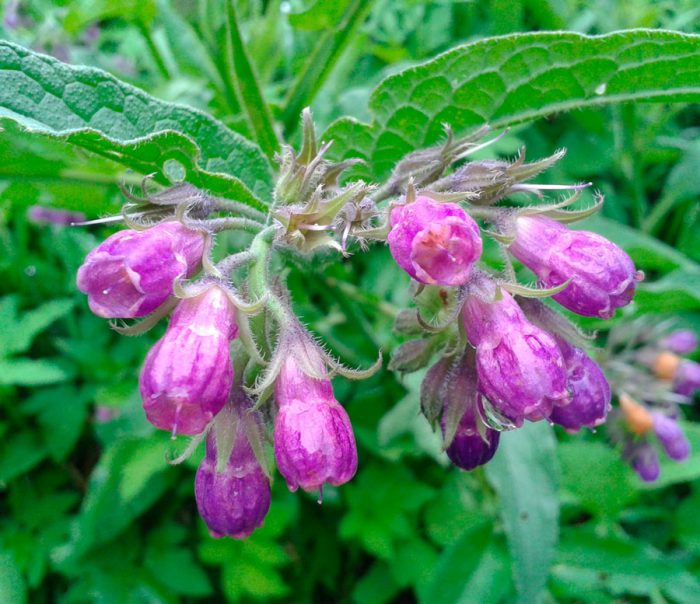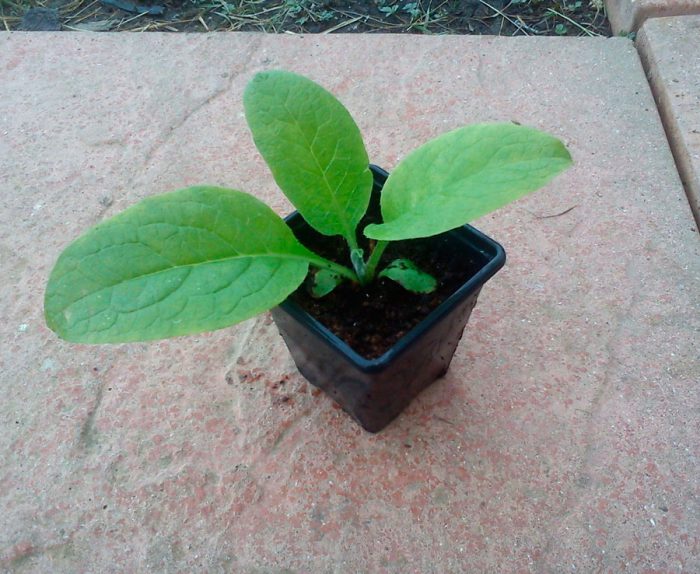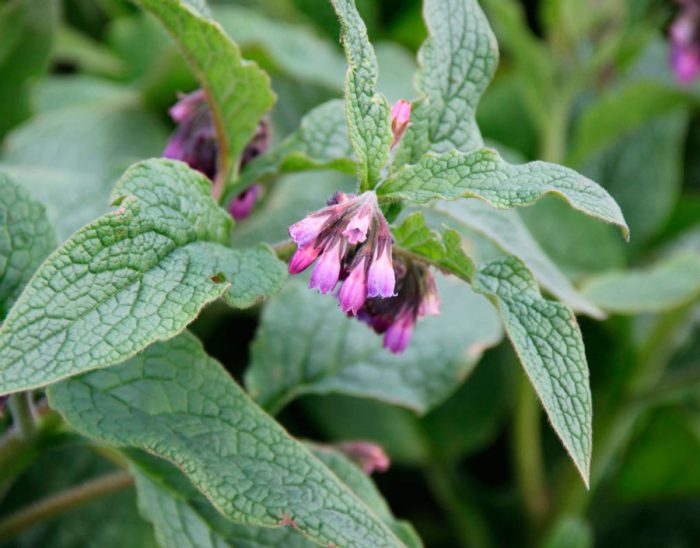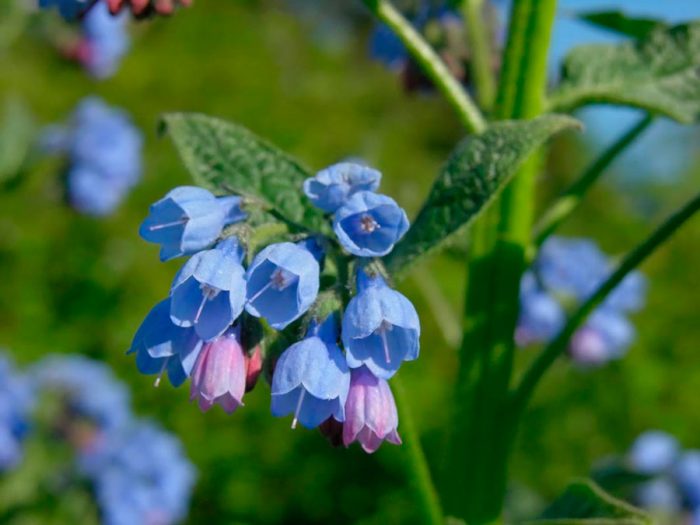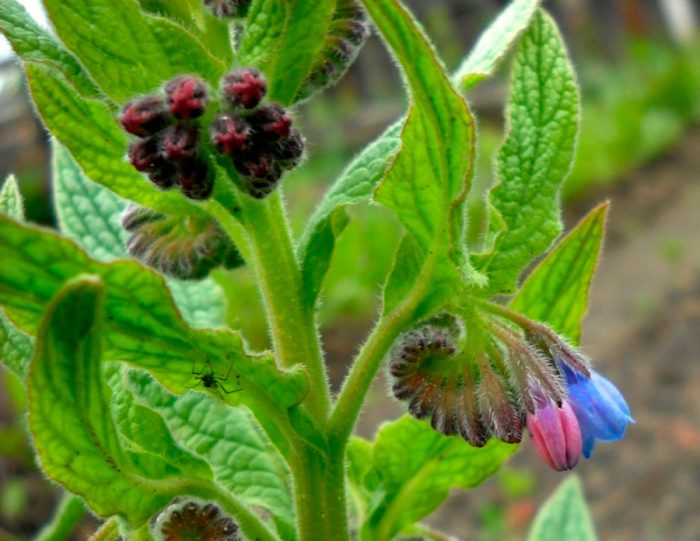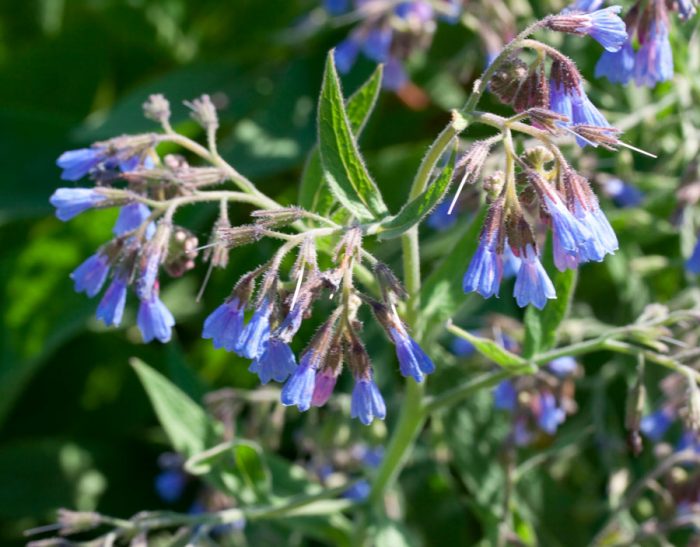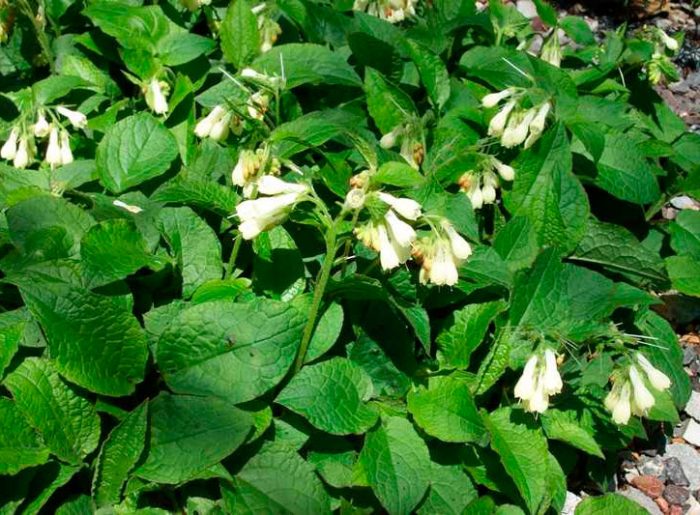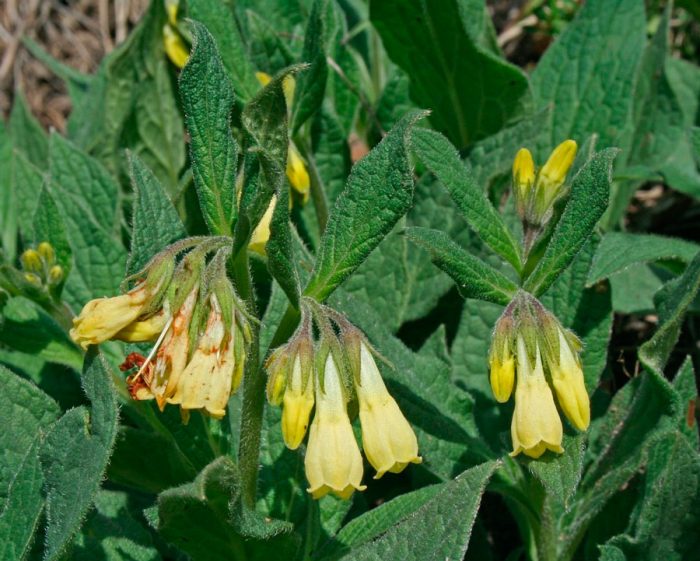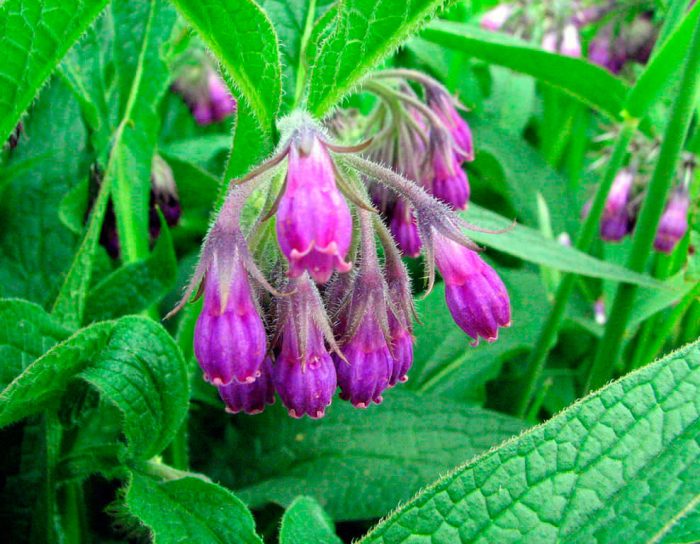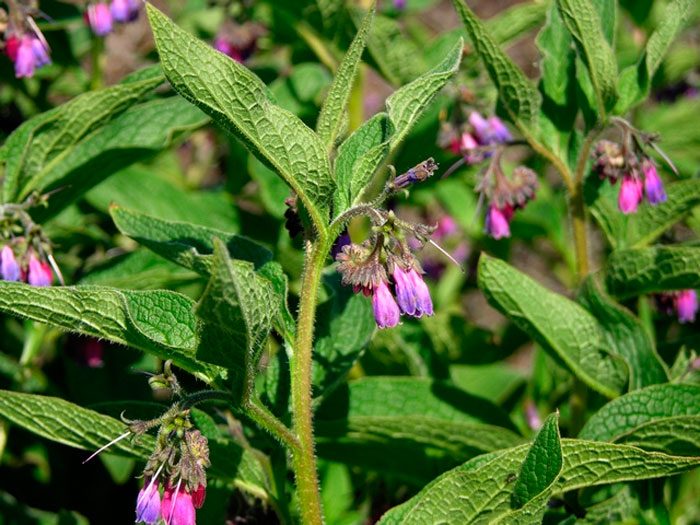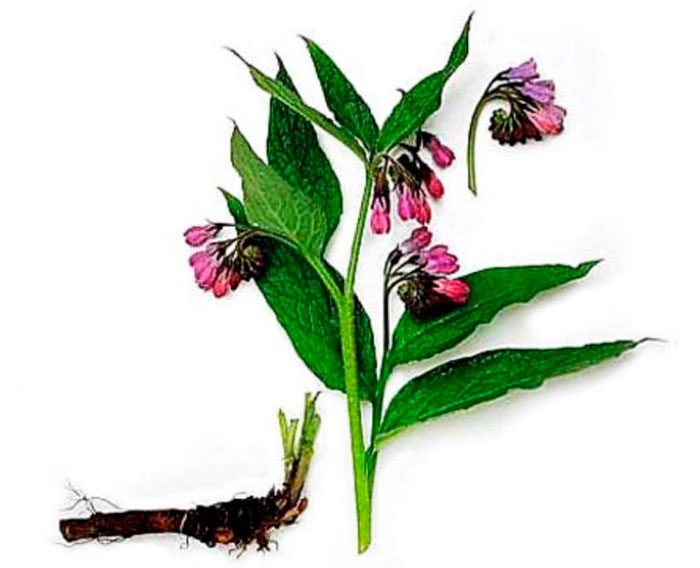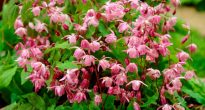Forest herbaceous perennial plant Comfrey (Symphytum), is a representative of the Borage family. In nature, it can be found from the British Isles to the western regions of Asia. This genus unites about 20 species, but the typical species is the medicinal comfrey, which is also called the larkspur. The Latin name for such a plant comes from the Greek word translated as "connect" or "splicing". The fact is that comfrey has been used for a long time in the treatment of bone injuries. Even among the people, comfrey medicinal is called vis-grass, greasy root and bone breaker.
Content
- 1 Comfrey features
- 2 Growing comfrey in the garden
- 3 Types and varieties of comfrey with photos and names
- 3.1 Comfrey rough (Symphytum asperum), or rough, or hard
- 3.2 Foreign Comfrey (Symphytum peregrinum)
- 3.3 Caucasian comfrey (Symphytum caucasicum)
- 3.4 Large comfrey (Symphytum grandiflorum)
- 3.5 Comfrey tuberous (Symphytum tuberosum)
- 3.6 Comfrey (Symphytum officinale)
- 3.7 Hybrid comfrey (Symphytum x uplandicum), or variegatum comfrey
- 4 Comfrey properties: benefits and harms
Comfrey features
The large root system of comfrey has thick, branched roots and numerous processes. The outer surface of the roots is almost black, but inside they are juicy and have a white color, greasy to the touch. There is pubescence on the surface of straight thick shoots with spreading branches. Large alternate leaf plates are ovoid and pointed at the top. The upper leaf plates are practically sessile, while the lower ones are petiolate, and there is a rough pile on their surface. Bell-shaped flowers can be colored lilac, red or purple. They are part of a racemose inflorescence that looks like a one-sided curl that grows at the top of the stem. Over time, the flowers turn cream or blue. This plant blooms in May – July. The composition of the fruits includes 4 single-seeded nuts with a smooth surface, their ripening is observed in July – September.
In nature, comfrey prefers to grow on moist nutrient soil. It can be found in river floodplains, along streams, and also in damp meadows.
Growing comfrey in the garden
Landing
For growing comfrey, you can choose both a well-lit and shaded area. However, it will grow best under the lacy shade of trees. When grown in open ground, this plant is considered quite aggressive, it actively grows and at the same time captures the territories where other crops grow.This plant is undemanding to the composition of the soil, but it has been noticed that it grows poorly on heavy, dry or overly acidic soil.
Before proceeding with planting, the selected area is subjected to digging to the depth of a shovel bayonet, while organic matter must be added to the soil (for 1 square meter of the site from 5 to 6 kilograms of humus or compost). The sowing of comfrey seeds is carried out in prepared grooves in spring or late autumn. The row spacing should be about 0.6 m. If you decide to sow in the spring, then the seed material must first be stratified. To do this, it is combined with moistened sand and placed on a refrigerator shelf designed for vegetables for 6-8 weeks.
If the sowing was carried out in the spring, then the first shoots should appear in 15–20 days, however, as a rule, they will be quite rare and uncommon. But after the autumn sowing in the spring, the seeds germinate together. In the first year of growth, only a basal leaf rosette is observed in the bush. And already from the second year flowering and fruiting are observed. Comfrey can be grown in the same place for three to four years.
Comfrey Garden Care
Such a herbaceous plant is undemanding to care for. Water it sparingly. However, during a prolonged drought or on hot days, make sure that the soil on the site does not dry out. Remember that there should always be order on the bed with comfrey, which means that you need to pull out weeds in a timely manner, and after each watering or rain, loosen the soil surface between the rows.
This plant does not particularly need feeding. However, it responds well to the introduction of organic matter into the soil, for example, a solution of bird droppings or mullein. This plant is highly resistant to frost, so it does not need shelter for the winter. In order to avoid overgrowth in the garden, such grass should be systematically mown.
Diseases and pests
Comfrey is very resistant to both harmful insects and various diseases. But if it is grown in very unfavorable conditions, then in extremely rare cases it can be affected by rust. As a rule, this herbaceous perennial is grown as a medicinal plant, and therefore experts do not advise using fungicidal preparations for its treatment. Instead, rusty bushes should be sprayed every half month with a solution consisting of 4 liters of water, 1 small spoonful of liquid soap, 1 aspirin tablet, and 1 large spoonful of vegetable oil and soda are added to it. However, before proceeding with the treatment, it is necessary to dig up all the heavily affected bushes and destroy them.
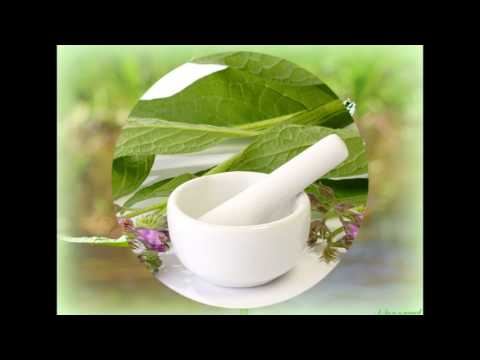

Watch this video on YouTube
Types and varieties of comfrey with photos and names
Not a very large number of comfrey species are cultivated by gardeners, while some of them have both healing properties and a decorative appearance.
Comfrey rough (Symphytum asperum), or rough, or hard
Under natural conditions, this species can be found in the Caucasus, while it prefers to grow in meadows, forest edges, and also along the banks of mountain springs, streams and rivers. This species is widely cultivated as a fodder plant. On the surface of the foliage and shoots there is a hard pubescence, and the bushes are decorated with blue flowers.
Foreign Comfrey (Symphytum peregrinum)
This species is considered a Caucasian endemic. Outwardly, the bush is very similar to rough comfrey, but its pubescence is less rigid. These two species have many similarities and, most likely, that is why some experts believe that foreign comfrey is just a kind of hard comfrey.
Caucasian comfrey (Symphytum caucasicum)
This perennial long-rhizome plant reaches a height of about 100 cm. The flowers are rich blue, lush bloom is observed in June and July.This species also has a white-flowered garden form.
Large comfrey (Symphytum grandiflorum)
In nature, this plant is found in the Caucasus in mountainous mixed forests. There is no need to care for such a carpet-like shrub, its stems are about 0.3 m high. There is pubescence on the surface of the oval dark green leaf plates. Blooming is observed in May. Inflorescences of a tubular shape of a creamy yellow hue are part of the bundles. Popular varieties:
- Goldsmith - green leaf plates have edging, which is a greenish-creamy green strip.
- Hidcoal Blue - the height of a wide bush is about 0.4 m, the inflorescences are white-blue.
Comfrey tuberous (Symphytum tuberosum)
This species is native to the northwestern part of Turkey, the Pyrenees and the Balkans. Its underground rhizome is very powerful. The height of the bush is about 50 cm, in the first summer weeks, yellow flowers open on it.
Comfrey (Symphytum officinale)
This species has a short rhizome. It is widespread in Western Siberia, Central Asia, Eastern Europe and the Caucasus. Such a plant prefers to grow in the chernozem zone in moist soil. The height of the shoots is about 100 cm. The oblong large leaf plates appear winged. There is pubescence on the surface of foliage and shoots. The curls are composed of dark purple or pink flowers.
Hybrid comfrey (Symphytum x uplandicum), or variegatum comfrey
The height of such a perennial is about 0.45 m. In the summer, the bush is decorated with tubular flowers, reaching 20 mm in diameter, they have a pink or blue color. This species has a high frost resistance, it is not afraid of a drop in air temperature to minus 23 degrees. But if the bushes are planted in a well-lit area, then burns may appear on the surface of their leaf plates.
Comfrey properties: benefits and harms
Healing properties
In comfrey, foliage is used to make soups and salads. The rhizome of such a plant has healing properties; it is harvested at the beginning of the spring period or in the fall. The rhizome contains tannins, mucus, gums, resins, allantoin, alkaloids, as well as other useful substances necessary for the human body. Means made on the basis of the rhizome of such a plant are distinguished by an astringent, antimicrobial, anti-inflammatory, enveloping and hemostatic effect. This plant is used in the treatment of gout, arthrosis, arthritis, bone tuberculosis and inflammation of the periosteum. In alternative medicine, compresses, baths, washing, tinctures of comfrey with alcohol and ointments are made from it, which are used in the treatment of skin diseases, wounds, fractures, bruises and ulcers. Infusion of rhizomes in milk helps with diseases of the lungs and kidneys, as well as inflammation of the oral mucosa. A decoction of rhizomes is used in the treatment of stomach ulcers, and tincture is used for uterine tumors. Decoctions and ointments are suitable for external use.


Watch this video on YouTube
Contraindications
Comfrey contains poisonous substances, in this regard, it must be used with great care and only under the supervision of the attending doctor. Comfrey-based preparations cannot be used during pregnancy, as well as for people who have individual intolerance. If you have no contraindications to the use of such a plant, then before using it for the first time, you still need to consult with a qualified specialist.

